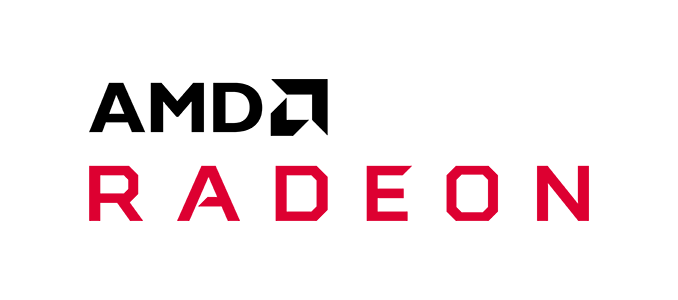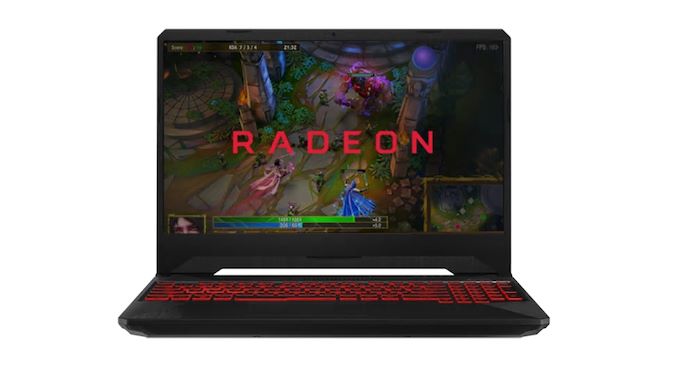AMD Quietly Releases Low-End OEM Radeon 600 Series: Radeon Rebadge 2019
by Ryan Smith on August 13, 2019 1:30 PM EST
While AMD’s focus with the launch of their Radeon RX 5000 series “Navi” product stack has been on midrange desktop cards – and rightfully so – it’s not the only market AMD serves. For as much as the company gets to set their own cadence in hardware design cycles, when it comes to hardware release cycles the company still needs to move to the beat of their single biggest customers: the OEMs. And with the OEMs being driven by market trends and seasonal, cyclical matters, OEMs have historically asked for new hardware between actual design cycles.
To that end, today AMD has quietly announced a new generation of products (of sorts), the Radeon 600 series. Aimed at the low-end of the market – and primarily laptops at that – the Radeon 600 parts are a pure rebadge of AMD’s existing 500 series parts, and are designed to flesh out the very bottom of AMD’s product stack. As is typical for low-end parts, these entries are based on a mix of existing AMD GPUs, using Polaris 12/23, GCN 3 “Topaz”, and GCN 1 “Oland” GPUs depending on the performance class.
Overall, this segment of the market is at the very tail end of AMD’s product stack. So low, in fact, that this is the segment where AMD doesn’t even produce new GPUs, as this is where higher-end integrated GPUs take over and the demand isn’t there for super small discrete GPUs. Hence the hodge-podge mix of GPUs; it’s essentially a collection of AMD’s lowest-end GPUs from a few generations, for the specific customers that need them.
As for the rebadging, this is a semi-annual event driven by OEM product cycles. In short, with the shorter product cycles of OEM systems versus retail channel video cards, OEMs want to advertise the latest components when they refresh and update their systems, even when new GPUs are not available. To which NVIDIA and AMD rebrand, refresh, or otherwise re-designate existing SKUs as new OEM-exclusive parts.
| AMD OEM Desktop & Mobile Radeon 600 Series | ||||||||
| Radeon RX 640 |
Radeon 630 |
Radeon 625 | Radeon 620 | Radeon 610 | ||||
| Base Model | Radeon 550X |
Radeon 540X |
Radeon 535 | Radeon 530 | Radeon 520 | |||
| Compute Units | 10 (640 SP) |
8 (512 SP) |
8 (512 SP) |
6 (384 SP) |
6 (384 SP) |
5 (320 SP) |
||
| Texture Units | 40 | 32 | 32 | 24 | 24 | 20 | ||
| ROPs | 16 | 8 | 8 | 8 | 4 | |||
| Boost Clock (up to) | <= 1287MHz | <= 1219MHz | <= 1024MHZ | <= 1024MHz | <= 1030MHz | |||
| Memory Clock | 7 Gbps GDDR5 | 6 Gbps GDDR5 | 4.5 Gbps GDDR5 | 4.5 Gbps GDDR5 or ? Gbps DDR3 |
4.5 Gbps GDDR5 | |||
| Memory Bus Width | 64-bit | 64-bit | 64-bit | 64-bit | 64-bit | |||
| VRAM | 2GB/4GB | |||||||
| Transistor Count | 2.2B | 3.3B | 1B | |||||
| GPU | Polaris 12/23 | Topaz | Oland? | |||||
| Process | GlobalFoundries 14nm | TSMC 28nm | ||||||
| Architecture | GCN 4 | GCN 3 | GCN 1 | |||||
| Listed Segment(s) | Desktop Laptop |
Desktop Laptop |
Laptop | Laptop | Laptop | |||
| Launch Date | 08/13/2019 | |||||||
Looking at the parts themselves, there’s not a ton to say here. At the top of the new Radeon 600 series is the Radeon RX 640, which is the only part to get an RX designation. Based on the specs, this would be a Polaris 12/23 part, which is AMD’s smallest GCN 4 GPU. The specs are line-for-line identical to the Radeon 550X, so AMD has not made any changes here. Overall, this part uses cut-down versions of the underlying Polaris GPU, with a mix of 8 CU and 10 CU versions. More notably, half of the memory bus has been lopped off, leaving just a 64-bit memory bus that’s running 7Gbps GDDR5.
Below the Radeon RX 640 is the Radeon 630. This appears to be another Polaris 12/23 part, this time recycling the Radeon 540X. Relative to the fastest part in the stack, this only comes with 8 CUs, and half of the ROPs have been disabled, leaving 8. Memory bandwidth has also been cut down a bit as well, dropping down to 6Gbps.
Past this, we have the Radeon 625, Radeon 620, and Radeon 610. While AMD’s website currently lists these are all being GCN 4 parts, the specifications are actually a perfect match for the Radeon 535, 530, and 520 respectively. Which is to say we’re looking at GCN 3 “Topaz” for the first two parts, and, refusing to die, GCN 1 “Oland” for the Radeon 610. These parts come with 6 or fewer CUs, with maximum clockspeeds at 1030Mhz or lower. Depending on the part, these come with 4.5Gbps GDDR5, or DDR3. Notably, none of the parts here have video decoders; they are meant to be entry-level parts for improving GPU performance in laptops, relying on the integrated GPU for video duties.
Overall, the release of the Radeon 600 appears to be timed to coincide with the launch of Intel’s 10th generation Core CPUs, which will begin showing up in laptops in September. While I don’t expect we’ll see these AMD parts paired with Intel’s latest wares – which tend towards the high-end – the launch of the 10th gen Core series is triggering a complete cascade of laptop family refreshes as the OEMs redo their product stacks. To that end, while AMD’s share of the laptop GPU market is relatively small, they still remain a common sight thanks to Radeon parts such as these.
Source: AMD











27 Comments
View All Comments
evernessince - Wednesday, August 14, 2019 - link
Almost a quarter as bad as a DDR3 GTX 1030, which Nvidia failed to properly label and did sell to the average customer. The AMD cards here can't even be purchased by regular people so there is zero harm to anyone. Let's not also forget the two different models of MX150's, which once again Nvidia failed to disclose the significant differences between and the binned RTX 2070 cards where the binned part was sold for more.I find comments like this funny, because you are sitting here complaining about an OEM only product line that will have zero impact on yourself and it's certain that OEMs will check the specs before ordering thousands. On the other hand Nvidia rebrands and mislabels cards more then once a year and because they are the market leader tons of PC gamers get dueped but I guess that's not a problem eh?
playtech1 - Wednesday, August 14, 2019 - link
These GPUs will be bought by many regular people when they buy a laptop. I don't blame AMD and Nvidia for meeting OEM demand, I just wish the OEMs demanded a bit more!sing_electric - Wednesday, August 14, 2019 - link
I mean, the "harm" is that it makes performance comparisons more difficult for average customers. There's got to be a few people who think "discrete graphics > embedded" and then "6xx > 5xx" and so they might choose a newer laptop model... that actually has an older GPU. I get why AMD's donig this - it probably makes the OEMs happy - but it's really confusing. (On the other hand... at this point, you basically need a fairly large spreadsheet to explain GPU hierarchies to someone. Oh, yeah, well, the Vega 56 is faster than the RX 580, but slower than the 5700... oh, but the VII is faster than both. The 1080 is going to be faster than the 1660, but the 2060 is faster and newer..." etc.)PeachNCream - Thursday, August 15, 2019 - link
While I'm not shocked that someone with irrational brand loyalty was triggered by my comment, I am disappointed.Since you're seemingly incapable of buying a clue for yourself, here's one for free - Criticism of a company's products does not imply mindless, slobbering brand loyalty to said company's competitor. Now calm yourself down and maybe next time, move your brain's gear selector to something other than neutral before hammering all over your keyboard in frothy-mouthed, rabid anger.
Lew Zealand - Tuesday, August 13, 2019 - link
The Radeon 540X/630 is still about 2x the speed of Intel's fastest Iris Plus iGPUs so there's still a little bit of value left there.olafgarten - Tuesday, August 13, 2019 - link
So... add 90 to each model number and it's brand new?Good Job AMD! (Not that Nvidia doesn't do the same)
plewis00 - Tuesday, August 13, 2019 - link
At least AMD renamed them so you know. After nVidia’s ‘GT 1030’ shenanigans I’d struggle to trust them again for low-end plug in cards.Dragonstongue - Wednesday, August 14, 2019 - link
Nv does their best to hide the little details, far far more than AMD really tries to do, than they also saddle more crud in there as well as not "support" their consumers with the "very best" considering they always want the very highest pricing, they not start at "tolerable"Nah they slap a G or Nv on it and so want X extra
"The way we play you"(tm) by Ngreedia lool
evernessince - Wednesday, August 14, 2019 - link
They aren't pretending it's new and they aren't selling them to regular customers. If you read the article it specifically stated that OEMs asks for new cards yearly, rebrand or not.There's a big damn difference between this and the BS Nvidia plays like selling two different versions of a card under the same name. IE 1030 DDR3 vs 1030 GDDR5 and MX150 (which has two variants with significant differences).
haukionkannel - Wednesday, August 14, 2019 - link
Does this mean that small Navi does not come out 2019?